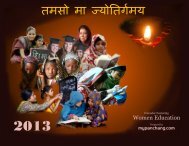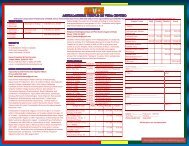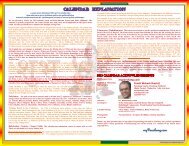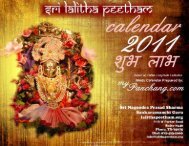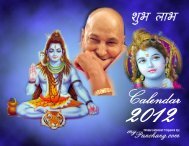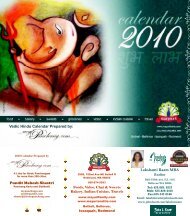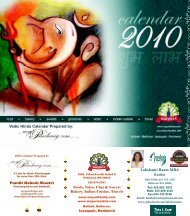11 - myPanchang.com
11 - myPanchang.com
11 - myPanchang.com
You also want an ePaper? Increase the reach of your titles
YUMPU automatically turns print PDFs into web optimized ePapers that Google loves.
CalendarExplanationWe are pleased to release the 20<strong>11</strong> calendar based on Hindu dharma shastra and drika siddhanta. Thiscalendar is specially prepared for the Greater Seattle area, and it may not be applicable in other parts ofthe world. All time presented here is adjusted for Daylight Saving Time.Calendar Types: There are two main types of calendars. One is the Solar Calendar which is used inTamilnadu, Orissa, Bengal, and Kerala. The other is a Luni-Solar Calendar based on Chandramasa. Inthe Luni-Solar calendar there are two types: Amavasyant - months ending in Amavasya; and Purnimant -months ending on Purnima. The Amavasyant is used in Gujarat, Maharastra, Karnataka, AndhraPradesh, Tamilnadu & Kerala (along with Solar Calendar). The Purnimant calendar is used in NorthIndia.Tithi: In the lunar calendar the Moon takes a month for each revolution around the Earth. The lunarcalendar is divided into two groups called Pakshas. The first one is called Krishna Paksha (or darkfortnight) which is when the Moon is waning. The second is called Shukla Paksha (or bright fortnight)which is when the Moon is waxing. Each Paksha is divided into 15 Tithis. The first 14 Tithis are theSanskrit numbers from 1 to 14 (Prathama, Dvithiya etc). The 15th Tithi of Shukla Paksha is Poornima(full Moon) & the 15th of the Krishna Paksha is Amavasya (Moon is not visible as it is closest to the Sun).So a lunar month consists of 30 Tithis and each Tithi then corresponds to the time taken by the Moon tomove 12 degrees with respect to the Sun. Krishna Paksha Tithis are in the darker color and Shukla PakshaTithis are mentioned in the red color.Nakshatra: There are 27 Nakshatra (constellations) in the Zodiac. A Nakshatra is the zodiacconstellation in which the Moon is found on the particular day. Nakshatras are in italics.Timings listed in the Calendar: The times listed after a Tithi & Nakshatra are the times at whichthe Tithi or Nakshatra ends. The Panchanga uses the Vedic definition of a day, i.e., a day starts withSunrise and ends with the subsequent Sunrise. Thus, a Tithi with a time of 29:00 indicates that the Tithiends before the next Sunrise. According to the western calendar, this means that the Tithi ends at 5:00 AM(29:00 – 24:00) on the next day. Hence 24:00 means 00:00 hours of the next day, 25:00 means 1:00 AM ofthe next day, 29:00 means 5:00 AM of the next day. This is standard for any Panchangam.How to read the Panchangam:The time next to the Tithi and Nakshatra is the time when it is going to end. If Tithi orNakshatra ends after midnight but before next Sunrise the end-time will have a value greaterthan 24 hours. To get actual time, please subtract 24 from the time. The English date and daywill be changed after midnight but not so for the Indian date and day. Indian day/date does notchange at midnight 0:00 hours and it is from one Sunrise to another Sunrise. e.g. Trayodashii08:18. This means Trayodashi ends at 8 hours 18 minutes.The time next to the nakshtra indicates when it is going to end. The same rules for Tithi timingsapply to Nakshatras as well. E.g. Rohinii 09:02. This means Rohini Nakshatra ends at 9 hours,02 minutes. Nakshatra is also known as a Star. This way you can find your child’s birth star.The time for Sun’s samkramana is when Sun will enter that rasi or sign on that day. e.g.Makara 4:36 means Sun is entering Makara rasi at 4 hour 36 minute.Uttarayana / Dakshinayana: The season occurs based on tropical Sun (without ayanamsha). This isdue to Earth’s tilt of 23.45 degrees. The Earth circles around Sun with this tilt. When the tilt is facing theSun we get summer and when the tilt is away from the Sun we get winter. Because of this tilt it seems likethe Sun travels north and south of the equator. This motion of the Sun is called Uttarayana – The Sun ismoving towards North and Dakshinayana the Sun is moving towards South. This motion of the Sunmoving towards the north is called Uttarayana. When it is moving towards the south it is calledDakshinayana. This causes rise to seaons. They are dependent on equinoxes and solstices.There is a <strong>com</strong>mon misconception that Makar Samkranti is the Uttarayana. This is because at one point intime Sayana and Nirayana Zodiac were same. Every year equinoxes slides by 50 seconds due to precisionof equinoxes, giving birth to Ayanamsha and causing Makar Samkranti to slide further. As a result if youthink Makar Samkranti is uttarayana then as it is sliding it will <strong>com</strong>e in June after 9000 years. HoweverInchin’s Bamboo Garden16564 Cleveland Street, Redmond, WA 98052Tel : 425 284 0670 Fax: 425 284 0671Chinese Swad India Ki YaadHindu VedicCalendarMakar Samkranti still holds importance in our rituals as a Samkranti. All Drika Panchanga makers willuse the position of the tropical Sun to determine Uttarayana and Dakshinayana. Hence January 14 th isn’tUttarayana. Actual Uttarayana occurs on December 21 st /22 nd of every year.For more details please visit http://www.<strong>myPanchang</strong>.<strong>com</strong> or write to shastriji@<strong>myPanchang</strong>.<strong>com</strong>.Guru Pushyaamrita Yoga: Specified in calendar. Good days to buy gold, & investments.Wedding / Graha Pravesha Muhurtha: These mentioned for every month.Kari Dina: Avoid Kari Dina for your auspicious activities. This calendar has marked Kari Dinas.Samkranti / Amavasya Tarpanam: They are marked in the calendar.About <strong>myPanchang</strong>.<strong>com</strong>: <strong>myPanchang</strong>.<strong>com</strong> is the most popular website site that provides themost accurate panchagam in English, Gujarati, Hindi, Kannada, Marathi, Telugu, and Tamillanguages as per North and South Indian calendar systems for over more than 350 cities all over theworld. Most temples in the world rely on <strong>myPanchang</strong>.<strong>com</strong> for accurate Panchang data and festivalobservance times. Please visit <strong>myPanchang</strong>.<strong>com</strong> for more details. The Panchang data and festivaldata presented here are the most accurate according to Hindu Vedic Tradition and in accordancewith Hindu dharma shastra. If you have any questions about confusion about any festival pleasecontact <strong>myPanchang</strong>.<strong>com</strong> and we’ll provide you with a further explanation.20<strong>11</strong> Calendar Acknowledgements:Panchangam DataFestivals &MuhurthasAdvisorsCalender DesignManagementArchitect<strong>myPanchang</strong>.<strong>com</strong>Pandit Mahesh ShastriDrik Panchangkarta and Panchang Siddhanti<strong>myPanchang</strong>.<strong>com</strong>, seattlepandit.<strong>com</strong>Dr. Ramchandra Joisa, Sistla Somayajulu,Rallabhandi Anjaneyulu, Santhosh Kumar Sharma GollapelliParantap Kumar Vyas, Pundit Sandip ShastrijiMonica Monasterio,Vikas Pulpa, Rama Srinivasan, Paddy RamaiyangerNayana Shastri, Sowjanya KodidalaRobert BeardsworthNotes: Any data presented here is copyright of <strong>myPanchang</strong>.<strong>com</strong> and its associates, any portionreproduced for <strong>com</strong>mercial purposes without prior written permission of <strong>myPanchang</strong>.<strong>com</strong> will be treatedas a violation of the United States copyright laws





